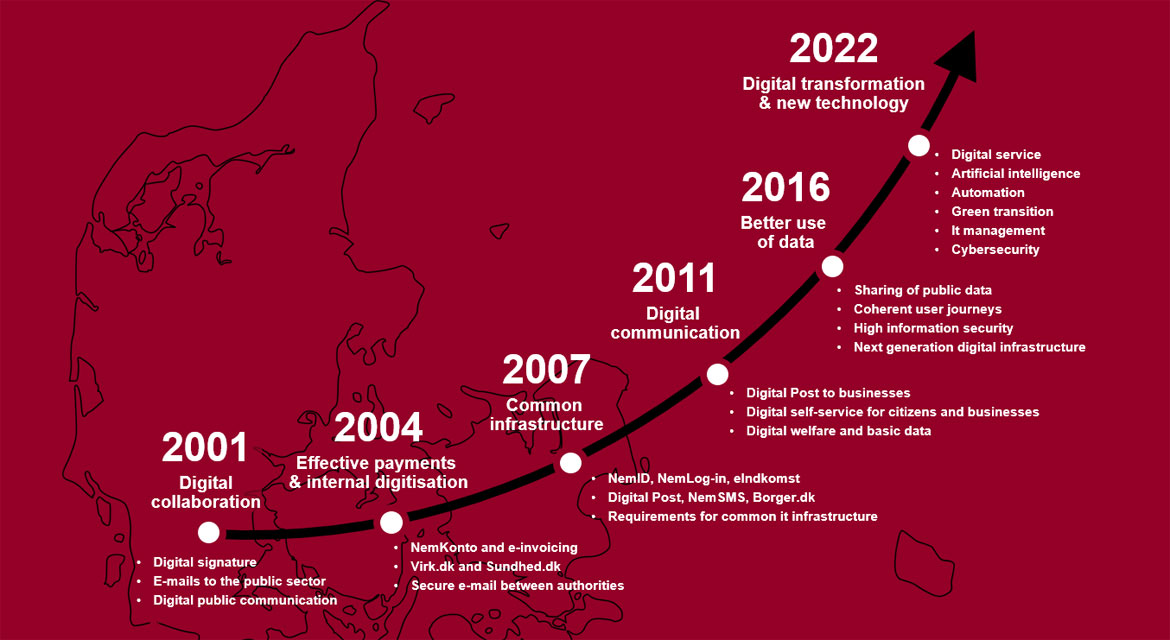Joint public collaboration as a cornerstone of digital development
The cornerstones of public digitisation and the widespread use of digital solutions in Denmark have been set through close and binding cooperation across the public sector for many years. This cooperation is based on joint public digitisation strategies, which are multi-annual agreements concerning the authorities at all levels of government, from central government to regions and municipalities.
The digital strategies make it possible for the public sector to make joint investments in areas which are particularly complex, and in which there are interdependencies across different authorities and sectors.
For instance, through the joint digitisation strategy effective from 2011 to 2014, a gradual transition to mandatory digital self-service and communication via Digital Post was initiated. This means that citizens and businesses today are required to use digital self-service for a wide range of services, and to receive digital letters, notices and messages from public authorities.
Furthermore, this has resulted in large infrastructure solutions that serve all citizens and companies in their daily lives and interactions with the public sector. This includes a recent new and updated digital post -solution and the citizen portal borger.dk. Moreover, the second-generation eID solution MitID serves as a personal entrance key to both the public sector and parts of the private sector, e.g. banks.
Danish citizens and businesses have generally welcomed the digital transition of Danish society, recognising the many advantages. Furthermore, there has been a large efforts devoted to help and guide those who find digital services hard to use.
The overall positive sentiment has only strengthened the political willingness to commit to further digital transition through – among other agreements – a new joint public digital strategy for the period 2022-2025.

Click here for a larger version of the illustration
The next steps in Denmark’s digital development
Digitisation has proven to be an effective and efficient tool to support processes and workflows in the public sector and increase the qualities of the services provided to citizens and businesses. Therefore, it is a political priority to keep developing Denmark’s digital public sector in accordance with the technological development.
In 2021, the Danish Government set up a Digitisation Partnership consisting of top-level executives and experts from the Danish business community, the research community, labour unions, civil society as well as partners from Local Government Denmark and Danish Regions. The purpose of the partnership was to discuss and provide recommendations to the Government as to how Denmark should harness and utilise future technological opportunities.
Read more about the Danish Government Digitisation Partnership
Following the recommendations provided by the Digitisation Partnership, the Danish Government launched a national strategy for 2022-2026. It is the first time the Government is launching a strategy covering both the public and the private sector. Among the strategy’s main themes are utilising new technologies to further improve Danish welfare and healthcare, encouraging the digital transition of businesses, supporting the green transition and promoting safe and ethical use of data and new technologies such as artificial intelligence in the public sector.
Read 'The Government Launches the New National Strategy for Digitalisation'
Lastly, the joint public collaboration on digitisation among the central government, the municipalities and the regions will continue as the backbone for public sector digitisation and service in Denmark. The Danish Government, Danish Regions and Local Government Denmark will launch a new joint public digital strategy for 2022-2025.
The strategy will, among other things, focus on how digitisation can help solve large societal issues such as the climate crises and labour shortage within the welfare areas. The strategy will outline the next steps in the Danish digital journey bringing all levels of the Danish public sector into the digital future for the good of citizens, businesses and authorities alike.